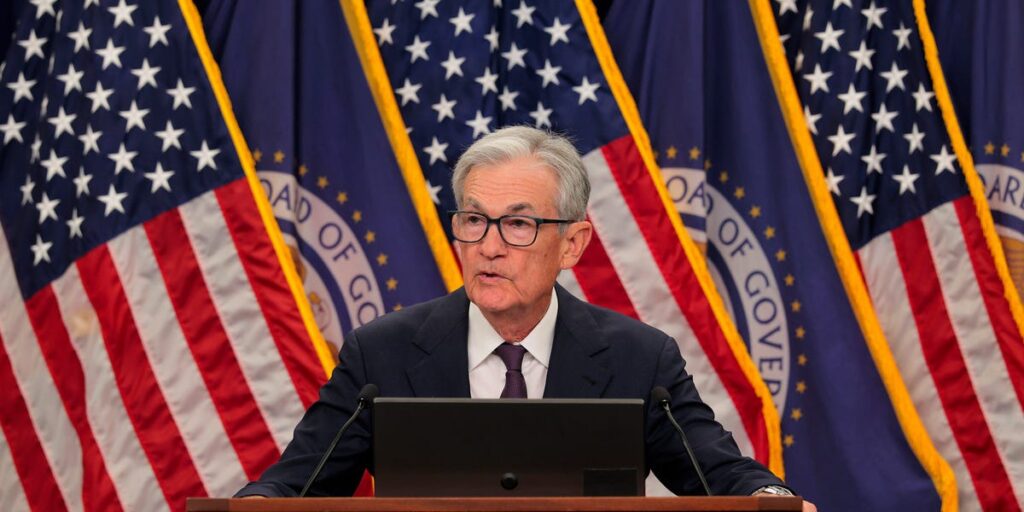The Fed is set to make its October interest rate decision on schedule, even as the government shutdown drags on.
In its seventh meeting of the year, the Federal Open Market Committee will likely opt for a quarter-point cut in its announcement on Wednesday. On Monday afternoon, CME FedWatch projected a 98% chance of a rate reduction, which would be the second of the year.
The circumstances for this week’s meeting are unusual: the government shutdown means that the Bureau of Labor Statistics didn’t publish a September jobs report, and the inflation data release was delayed from October 15 to October 24. With Congress stuck at a budget impasse, it’s unclear when the government will reopen — leaving Fed leaders without a full picture of America’s economic health.
Despite limited data, Fed Chair Jerome Powell is expected to announce another cut after a summer of slow job growth and unemployment creeping up. Inflation, at 3% as of September, remains above the Fed’s 2% goal. The Fed’s economic projections released last month also penciled in two more normal-sized rate cuts for the year, which are expected to bring relief to borrowers looking to finance homes, cars, and credit cards.
The Fed kept policy “at a restrictive level” earlier this year, Powell said. “And we were able to do that over the course of this year because the labor market was in very solid condition, with strong job creation,” he said at the September meeting, adding, “I can no longer say that.”
The Fed is missing a key piece of economic data
Without the latest jobs report, Fed leaders will have to rely on other economic indicators to make their rate decision.
Inflation data is crucial for one side of the Fed’s dual mandate. The consumer price index, one measure of inflation, rose slightly below the 3.1% forecast in September, hitting 3% for the first time since January.
Stephen Kates, a financial analyst at Bankrate, told Business Insider he expected the Fed to make a rate cut regardless of the new inflation data, but feels that cooler-than-expected rate cemented the decision.
“Even if we got slightly higher inflation, even if inflation could come in exactly at expectations, the Federal Reserve had made it relatively clear that they were more comfortable with the level of inflation that we’ve had relative to now the deterioration in the labor market,” Kates said.
Pre-shutdown patterns in the job market also make a strong case for a rate reduction. Openings have declined, and unemployment has been creeping up, meaning the market isn’t keeping up with the number of Americans looking for work. The central bank might not have the latest data, but Powell said last month that “the marked slowing in both the supply of and demand for workers is unusual,” and called for a less restrictive policy position.
The Fed may also lean on soft economic indicators to make its decision. A key marker of consumer sentiment, for example, dipped in October. It suggests that Americans are feeling the heat of high prices and limited job opportunities, meaning they’re less likely to spend money. Another rate cut could help stimulate a seemingly sluggish economy.
Not all Fed leaders agree on how much the bank should cut rates. A few committee members dissented from Powell’s restrictive policy patterns earlier this year, and one member called for a 1.25% rate reduction by the end of the year last month — far more than any other voting members.
President Donald Trump has also been vocal about his desire for more rate cuts.
“I really believe that Jerome ‘Too Late’ Powell is an OBSTRUCTIONIST!” he wrote in an October 1 Truth Social post.
Consumers could start to feel the impact of Fed decisions
A pattern of rate cuts could bring relief to consumers.
Thirty-year fixed mortgages, two-year auto loans, and credit card rates tend to move up and down alongside the federal funds rate, though this can change if there are major swings in inflation and investor behavior. And, though it takes time for Fed decisions to trickle down to Americans, consecutive months of cuts could spell good news.
Kates said Americans with high-yield savings accounts could see their interest earnings decline slightly over time.
“For people who are borrowing — so anybody who’s got a mortgage, is itching for a refinance, or anybody who’s got credit card debt or wants to take out a home equity line of credit — that’s something that they should start to plot,” Kates said.


